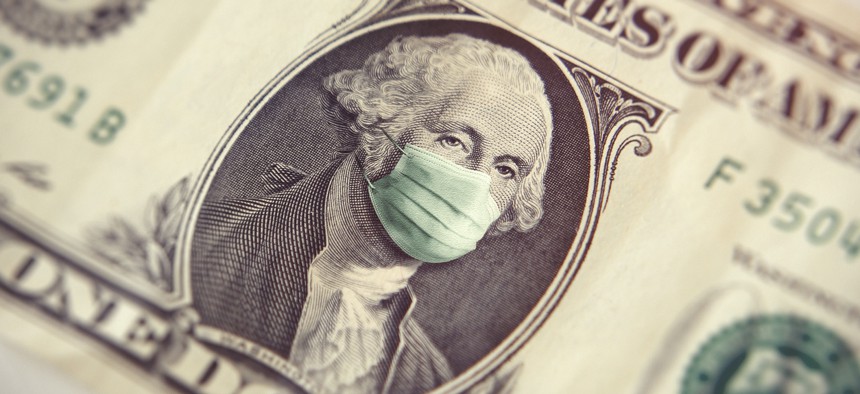One County Will Give $76 Million in ‘Hero Pay’ to Public Employees for Covid Response

istockphoto.com/narvikk
Most full-time workers in California’s Santa Clara County will receive $2,500 bonuses, all paid for with the county's federal Covid-19 relief allotment.
A California county will use more than $76 million in Covid relief money to fund “hero pay” bonuses for employees who “played a central role” in supporting response efforts during the pandemic.
The Santa Clara County Board of Supervisors approved the measure last month, granting every full-time county employee a one-time bonus of $2,500. Part-time employees will receive a prorated amount based on the number of hours worked, and state contractors who provided in-home supportive services will be eligible for a $500 bonus.
The payments will total roughly $76.3 million, funded via $187.2 million in federal relief money received by the county in May from the American Rescue Plan Act. (The county expects a second tranche of federal funding next spring.)
None of the county’s roughly 22,000 employees are excluded from the payment except for the five elected supervisors and the county executive, though workers can choose to donate the money or exempt themselves if they choose. The amount of the bonus is the same for employees whether they did their work in person or remotely, which County Executive Jeff Smith said was a conscious decision designed to honor every department equally.
“We felt strongly that everyone in the county’s employ actually participated vigorously, to the greatest extent possible, in providing a response to the pandemic,” he said at the board’s Oct. 5 meeting. “Therefore, we didn’t feel administratively that we could take a group, or a particular job or particular activity, and say that was more deserving of a larger amount of money than any other.”
That decision rankled some county employees, who felt their work as frontline responders warranted more recognition than office administrators who were able to do their jobs from the safety of their homes. Alicia Anderson, a senior manager with the county, told supervisors that she was reassigned as a disaster service worker in the early days of the pandemic, charged with helping to create and oversee a program to provide noncongregate shelter for homeless people in an effort to prevent the spread of the virus as well as protect the health of a vulnerable population.
In those days, Anderson reminded the supervisors, no one knew much about the virus, including how easily it spread or how deadly it was. Protective equipment was in short supply, and employees did not have emergency paid sick leave or any idea when a vaccine might materialize.
“I know the grueling 12-hour days, seven days a week, doing wellness checks up many flights of stairs outside in the hot sun and smoky air, or cold and windy rain,” she said in an email. “I know the real risk staff were at of contracting covid and the mental health toll with the constant crises they handled—daily 911 calls for medical and safety emergencies, de-escalating conflicts, being verbally and physically threatened, finding people passed away in their rooms and supporting their grieving families, and so much more.”
None of those employees were health-care workers or received special disaster-relief training, and most did not receive supplemental pay despite the increased workload and the risk it came with, she noted.
“Certainly we recognize that all county employees played a role in maintaining safety net services to the residents of Santa Clara County throughout 2020 and 2021,” she wrote. “But there is a substantial difference between folks who were able to do so within their chosen job codes, working safely and remotely from home (or even more so on paid administrative leave), and those who were involuntarily directed to report to a motel room and work out of there for 6, 12, or even 18 months for their $25-an-hour wage.”
Hero Pay Relatively Common
The notion of “hero pay,” or supplemental pay for state and local government work during the pandemic, is relatively common, Smith noted. “Premium pay” is an allowable use of relief money under the American Rescue Plan Act’s Coronavirus State and Local Fiscal Recovery Fund, which defines eligible employees as those who work “in critical infrastructure sectors who regularly perform in-person work, interact with others at work, or physically handle items handled by others,” but leaves final discretion to each government entity to define “essential work.”
“They listed certain criteria, and then said other criteria can be established by a local agency,” Smith said. “We recommended the $2,500 to be within the amount envisioned through ARPA, and recommended it for the entire employee population, because we realized that everyone contributed vigorously to the response.”
Eligible employees—anyone on the payroll as of June 28, 2021 and “still on paid status” at the start of the Nov. 15 pay period—should receive their payments early next month, pending negotiations with various unions.
It’s not clear exactly how many cities and counties have chosen to utilize federal funding for similar purposes. The National Association of Counties tracks covid relief funding expenditures via a general database, but does not keep tabs on “premium pay” specifically.
As of mid-October, only three of 12 Midwestern states had used relief dollars for extra employee pay, according to an analysis from the Economic Policy Institute. But a handful of other municipalities in California, including the cities of San Carlos and San Mateo, approved similar measures earlier this year.
Still, as of last month, only one other large county in California (San Diego) had allocated federal funding for bonuses, said Santa Clara County Supervisor Susan Ellenberg.
“I support the pandemic hazard pay for our workforce,” she said before voting in favor of the proposal. “I believe this speaks to our board’s appreciation for our employees and our commitment in recognizing their contributions.”
Kate Elizabeth Queram is a senior reporter for Route Fifty and is based in Washington, D.C.
NEXT STORY: The Government Job Application Drop-off is 'Snowballing'





